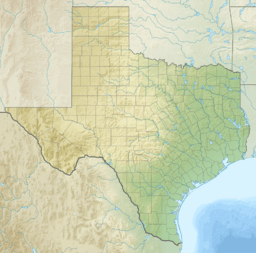Balmorhea Lake facts for kids
Quick facts for kids Balmorhea Lake |
|
|---|---|
 |
|
| Location | Reeves County, Texas |
| Coordinates | 30°57.77′N 103°43.25′W / 30.96283°N 103.72083°W |
| Type | Irrigation reservoir |
| Primary inflows | Sandia Creek, Toyah Creek |
| Primary outflows | Sandia Creek |
| Basin countries | United States |
| Surface area | 556 acres (225 ha) |
| Max. depth | 25 ft (7.6 m) |
| Water volume | 6,350 acre⋅ft (0.00783 km3) |
| Surface elevation | 3,187 ft (971 m) |
Balmorhea Lake is a man-made lake, also known as a reservoir. It's located in Reeves County, Texas, about 2 miles (3 km) southeast of the town of Balmorhea. This lake was created to help local farms by providing water for their crops. It's also a popular spot for people to visit and have fun outdoors. Sometimes, people call it Lower Parks Reservoir.
Contents
About Balmorhea Lake
Balmorhea Lake was built in 1917. It was created by building a dam across Sandia Creek. Water also flows into the lake from Toyah Creek, which is fed by the nearby San Solomon Springs. Extra water from the Phantom Lake Canal also helps fill the reservoir.
Historians believe that the area around Balmorhea Lake has been important for a very long time, possibly over 11,000 years! This means that ancient Native American tribes and many different animals, some of which are now extinct, likely used this area for resources.
Plants in the Lake
Balmorhea Lake is home to several interesting water plants. Two common types are Bulrush and Sago Pondweed. These plants are important for the lake's health.
Bulrush
Bulrush, also known as Scirpus acutus, is a plant that grows in wet areas like marshes. You'll often find it around lakes, ponds, and reservoirs. These plants have a special way of growing. Their stems spread out underground, and roots grow from them. This helps to protect the shoreline from being washed away by waves.
Bulrush plants also help keep the water clean. They produce a substance in the soil that helps bacteria break down waste. This stops pollution from harming the lake and the plants nearby. Bulrush usually grows in shallow water and can be over 2.5 meters (8 feet) tall. They are mostly green, sometimes with a gray tint.
Sago Pondweed
Sago Pondweed, or Stuckenia pectinata, is very common in North America. This plant is a favorite food for ducks, geese, and other birds that live near the water. Like Bulrush, Sago Pondweed helps the environment. It prevents the shoreline from eroding due to waves. It also helps control the amount of pollution in the water. These plants look like grass and can grow over 2.5 feet (0.76 meters) tall. They have a brownish-green color.
Fishing Fun
Balmorhea Lake is a great place for fishing! Different types of fish have been added to the lake to make it even better for people who enjoy fishing.
You can find many kinds of fish here, including:
- Largemouth bass
- Sunfish
- European carp
- Mirror carp
- Channel catfish
- Blue catfish
- Black bullhead
- Crappie
- Gizzard shad
Even though fishing is allowed, there are rules to follow. These are statewide regulations set by Texas to make sure everyone fishes safely and responsibly. You can find more information about these rules on the Texas Parks and Wildlife Department website.
What You Can Do at the Lake
Balmorhea Lake is a popular spot for many outdoor activities. It's a fun place for families and friends to spend time.
Some popular activities include:
- Swimming
- Fishing
- Bird-watching
- Diving]
- Boating



